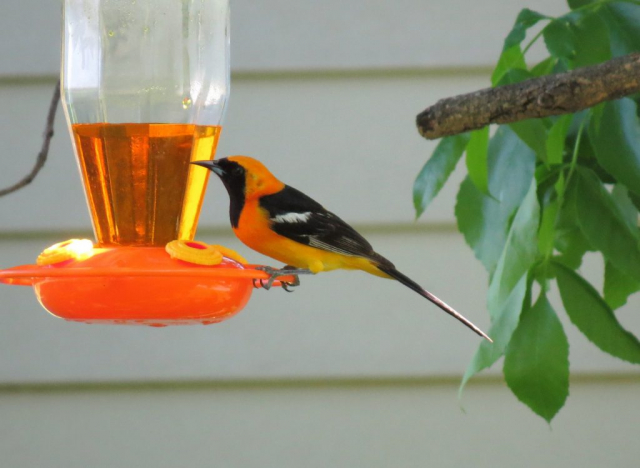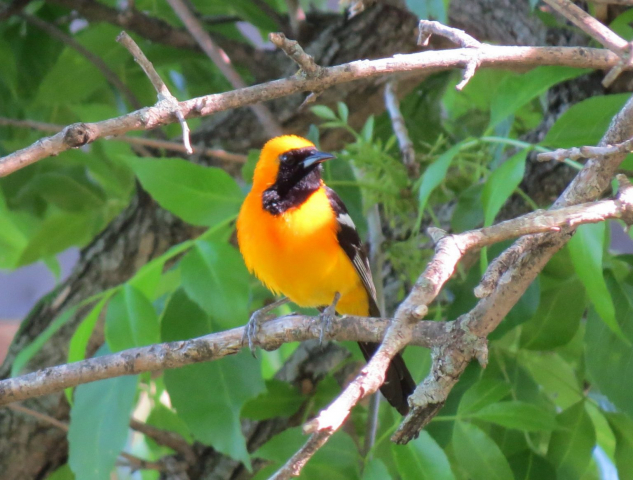Icterus cucullatus cucullatus
Status: Accidental in spring.
Documentation: Photograph: 26 May 2013 Garrison, Butler Co (Gubanyi 2013; photo above of the same bird 28 May 2013).
Taxonomy: Five subspecies are recognized, two in Mexico and Central America, and three in the US (AviList 2025): nelsoni, breeding and wintering in California and southwest Texas, cucullatus, breeding in south-central Texas, and sennetti, breeding in south Texas.
Based on the extensive black coloration above the bill and strongly orange coloration of the Nebraska bird, it is likely cucullatus (Jaramillo and Burke 1999).
Spring: The single record is:
25-29 May 2013 male at Daro family feeder, Garrison, Butler Co, (Gubanyi 2013).
This first state record was first noticed by Susie and Bill Daro at their oriole feeders. Recognizing that it was unusual, they contacted John Carlini who suggested they photograph the bird, which they did; the next day John Carlini and Shari Schwartz drove up to confirm the identification (Gubanyi 2013). It was subsequently seen by many observers.
There are two previous reports for Nebraska, but although suggestive, neither was confirmed. One was reported seen near Columbus, Platte Co on two days including 12 May 1965 (Armstrong 1965). Identification was based on an orange crown and “fiery orange” hood, rump, and underparts. While neither Baltimore nor Bullock’s Orioles nor their hybrids possess “orange crowns,” although first fall birds have greenish-orange crowns, no further detail was provided for this intriguing report. A similar report was of one at an oriole feeder tray in Moorefield, Frontier Co 30 Apr 2014 that had an “orange head”; no further details were provided, although at the same time a Hooded Oriole was seen by many in Douglas Co, Kansas 1 May 2014. One reported in Dawson Co 30 Jun 2017 was not accepted by NOURC (Brogie 2018).
Hooded Oriole has occurred as a winter vagrant north to Oregon, Washington, and British Columbia on the West Coast and along the Gulf Coast to Florida, but east of the Rocky Mountains Hooded Oriole is mostly a spring vagrant; there are 23 records north of the Gulf Coast and east of the Rocky Mountains, 16 of these Apr-Jun (eBird.org, accessed Jan 2024).
A banded bird recovered in Kansas identified as a Hooded Oriole was considered to have been incorrectly identified (Thompson and Ely 1992).
Images
Abbreviations
NOURC: Nebraska Ornithologists’ Union Records Committee
Literature Cited
Armstrong, J.R. 1965. Hooded Oriole. NBR 33: 65.
AviList Core Team, 2025. AviList: The Global Avian Checklist, v2025. https://doi.org/10.2173/avilist.v2025.
Brogie, M.A. 2018. 2017 (29th) Report of the NOU Records Committee. NBR 86: 131-142.
Gubanyi, J.G. 2013. First documented record of Hooded Oriole (Icterus cucullatus) in Nebraska. NBR 81: 161-164.
Jaramillo, A., and P. Burke. 1999. New World Blackbirds- The Icterids. Princeton University Press, Princeton, New Jersey, USA.
Thompson, M.C., and C.A. Ely. 1992. Birds in Kansas. Vol. 2. University of Kansas Museum Natural History Publications Educational Series No. 12, Lawrence, Kansas, USA.
Recommended Citation
Silcock, W.R., and J.G. Jorgensen. 2025. Hooded Oriole (Icterus cucullatus). In Birds of Nebraska — Online. www.BirdsofNebraska.org
Birds of Nebraska – Online
Updated 23 Jul 2025


